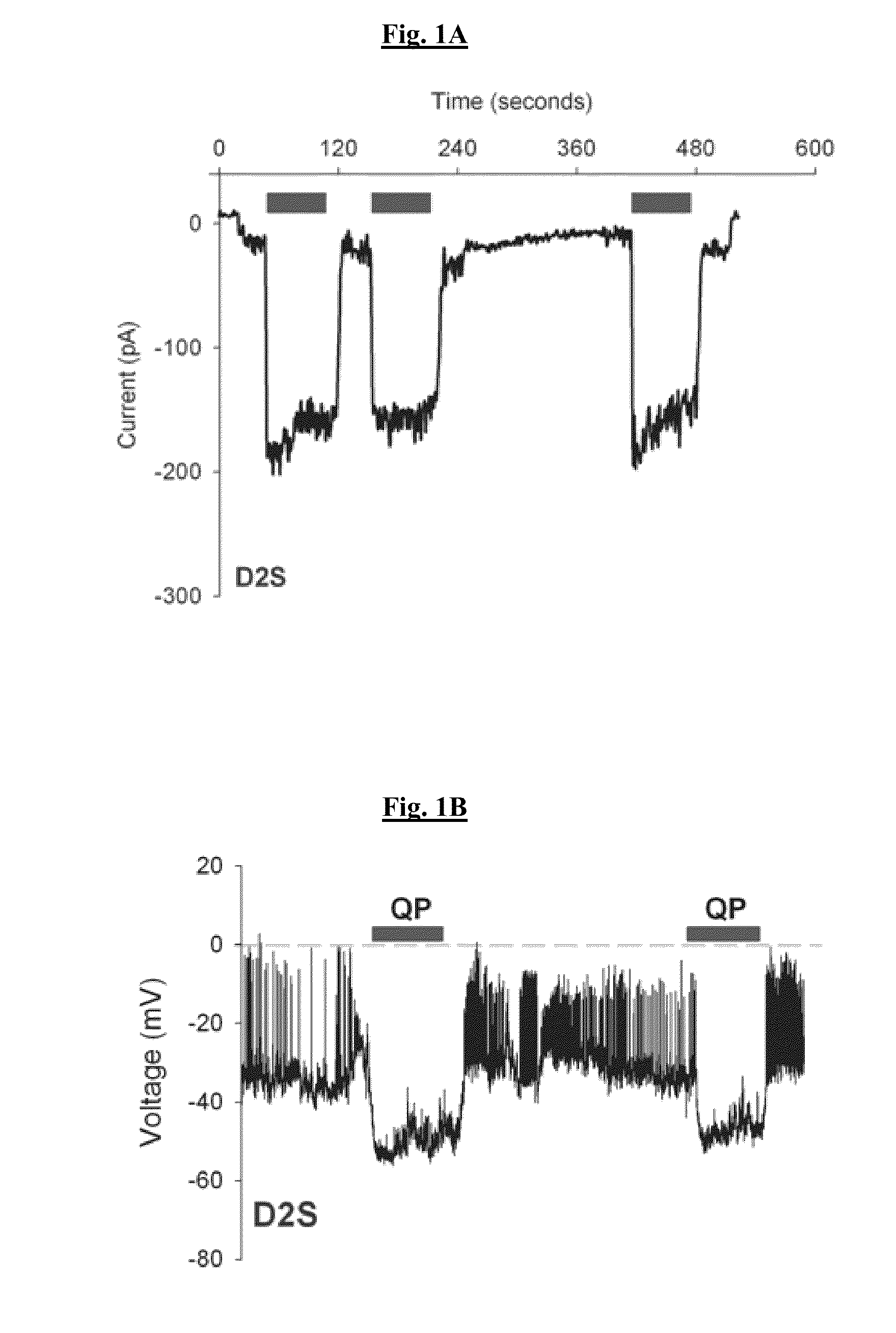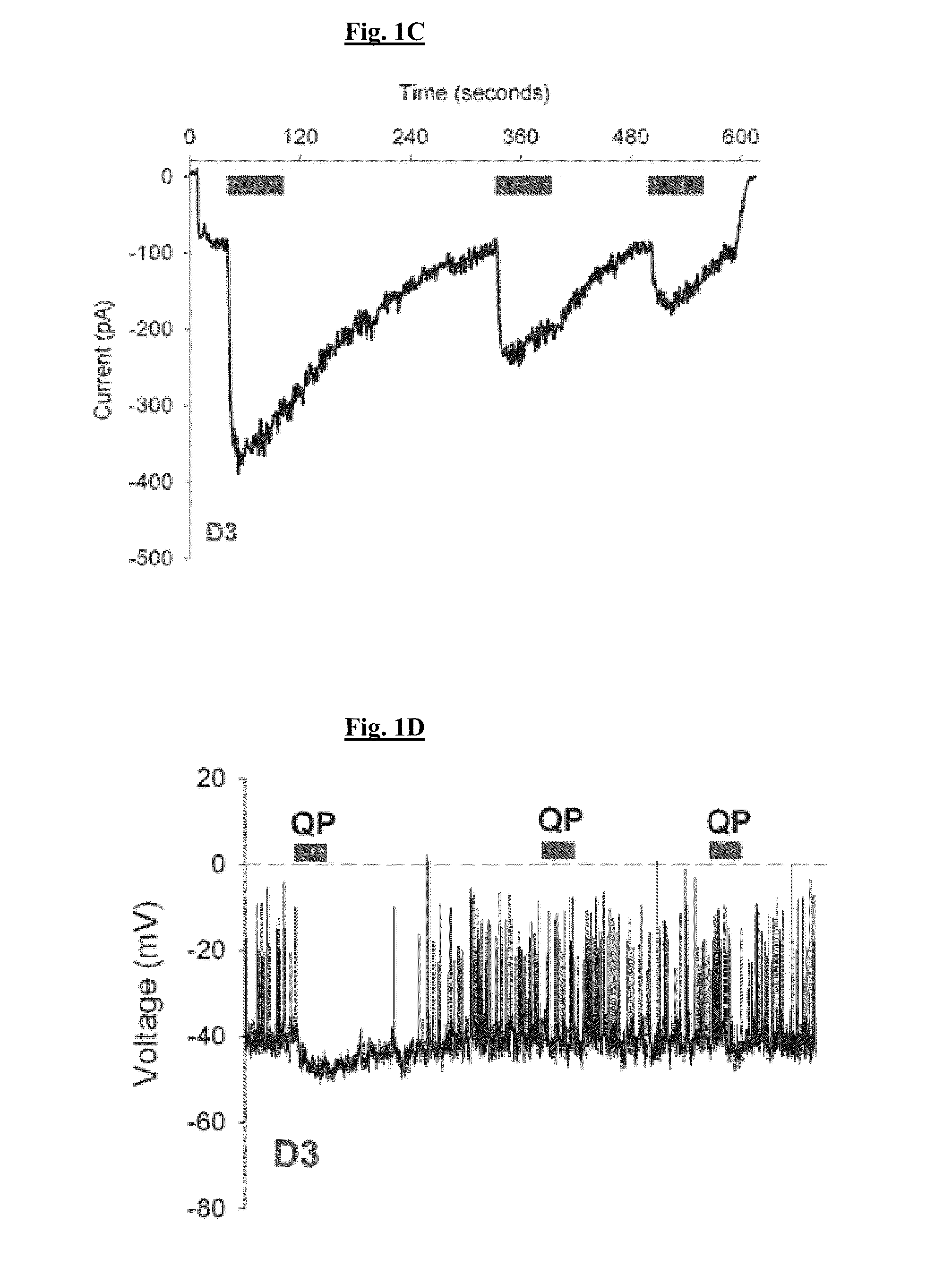Novel D3 Dopamine Receptor Agonists to Treat Dyskinesia in Parkinson's Disease
a parkinson's disease and d3 dopamine receptor technology, applied in the field of new d3 dopamine receptor agonists to treat parkinson's disease dyskinesia, can solve the problems of levodopa-induced dyskinesia (lid) being a particularly serious side effect, reducing endogenous formation, etc., to improve or prevent parkinson's disease in patients.
- Summary
- Abstract
- Description
- Claims
- Application Information
AI Technical Summary
Benefits of technology
Problems solved by technology
Method used
Image
Examples
example 1
In Vitro Characterization of Compounds
[0312]PBZI and 4-(2-chlorophenyl)-butan-2-amine were characterized for their interactions with dopamine receptors. Both compounds activated G-protein coupled inward rectifier potassium (GIRK) channels via D3 dopamine receptors (FIG. 2) and inhibited adenylyl cyclase activity (FIG. 11). The in vitro functional data for both compounds are shown in Table 1. Of most interest was the observation that unlike traditional D2 / D3 receptor agonists, PBZI and 4-(2-chlorophenyl)-butan-2-amine abolished the tolerance and SRT properties of the D3R (FIG. 2). These two compounds represent a new class of D3 dopamine receptor agonists that abolishes the tolerance and SRT properties of the D3 receptor while being a full agonist.
TABLE 1Characterization of PBZI & 4-(2-chlorophenyl)-butan-2-amine effect onD2-like receptor signaling function in AtT-20 stable cell lines)D2SD2LD3D4.2dopaminedopaminedopaminedopaminereceptorreceptorreceptorreceptorPBZIAdenylylpartialfullfu...
example 2
Ligand Dependent D3 Receptor Tolerance and SRT Properties
[0313]FIG. 9A illustrates the D3 dopamine receptor-induced activation of native GIRK channels when the receptor is stimulated with the endogenous agonist, dopamine. The tolerance property of D3 receptor is quantified as the ratio of 2nd to 1st agonist-induced response. The D3 receptor tolerance property is also observed in the D3 receptor-adenylyl cyclase and -mitogen activated protein kinase pathways (Kuzhikandathil & Bartoszyk, 2006, Neuropharm. 51:873-884; Westrich & Kuzhikandathil, 2007, Biochim. Biophys. Acta-MCR 1773:1747-1758). In addition, FIG. 9A shows the D3 receptor SRT property, which is the delayed termination of the agonist-induced response after agonist removal. Tolerant D3 receptor adopts a distinct conformation (Westrich et al., 2010, Biochem. Pharmacol. 79:897-907), suggesting that tolerance and SRT properties might be modulated by functionally-selective agonists that alter this distinct conformational state....
example 3
In Vivo Characterization of Compounds: In Vivo Behavioral Response
[0315]To determine the in vivo behavioral effect of the novel class of D3 dopamine receptor agonists, the effects of PBZI and a classical tolerance and SRT inducing D3 dopamine receptor agonist, PD128907 ((4aR,10bR)-3,4-a,4,10b-tetrahydro-4-propyl-2H,5H-[1]benzopyrano-[4,3-b]-1,4-oxazin-9-ol hydrochloride), were compared. FIG. 12 illustrates that PD128907 elicited a biphasic locomotor response in a novel open field activity test. In contrast, PBZI (which does not elicit tolerance and SRT) induced only a monophasic locomotor response. This novel result thus identified a potential behavioral screen for the new class of D3 dopamine receptor agonist described herein.
PUM
| Property | Measurement | Unit |
|---|---|---|
| time | aaaaa | aaaaa |
| pharmaceutical composition | aaaaa | aaaaa |
| time | aaaaa | aaaaa |
Abstract
Description
Claims
Application Information
 Login to View More
Login to View More - R&D
- Intellectual Property
- Life Sciences
- Materials
- Tech Scout
- Unparalleled Data Quality
- Higher Quality Content
- 60% Fewer Hallucinations
Browse by: Latest US Patents, China's latest patents, Technical Efficacy Thesaurus, Application Domain, Technology Topic, Popular Technical Reports.
© 2025 PatSnap. All rights reserved.Legal|Privacy policy|Modern Slavery Act Transparency Statement|Sitemap|About US| Contact US: help@patsnap.com



